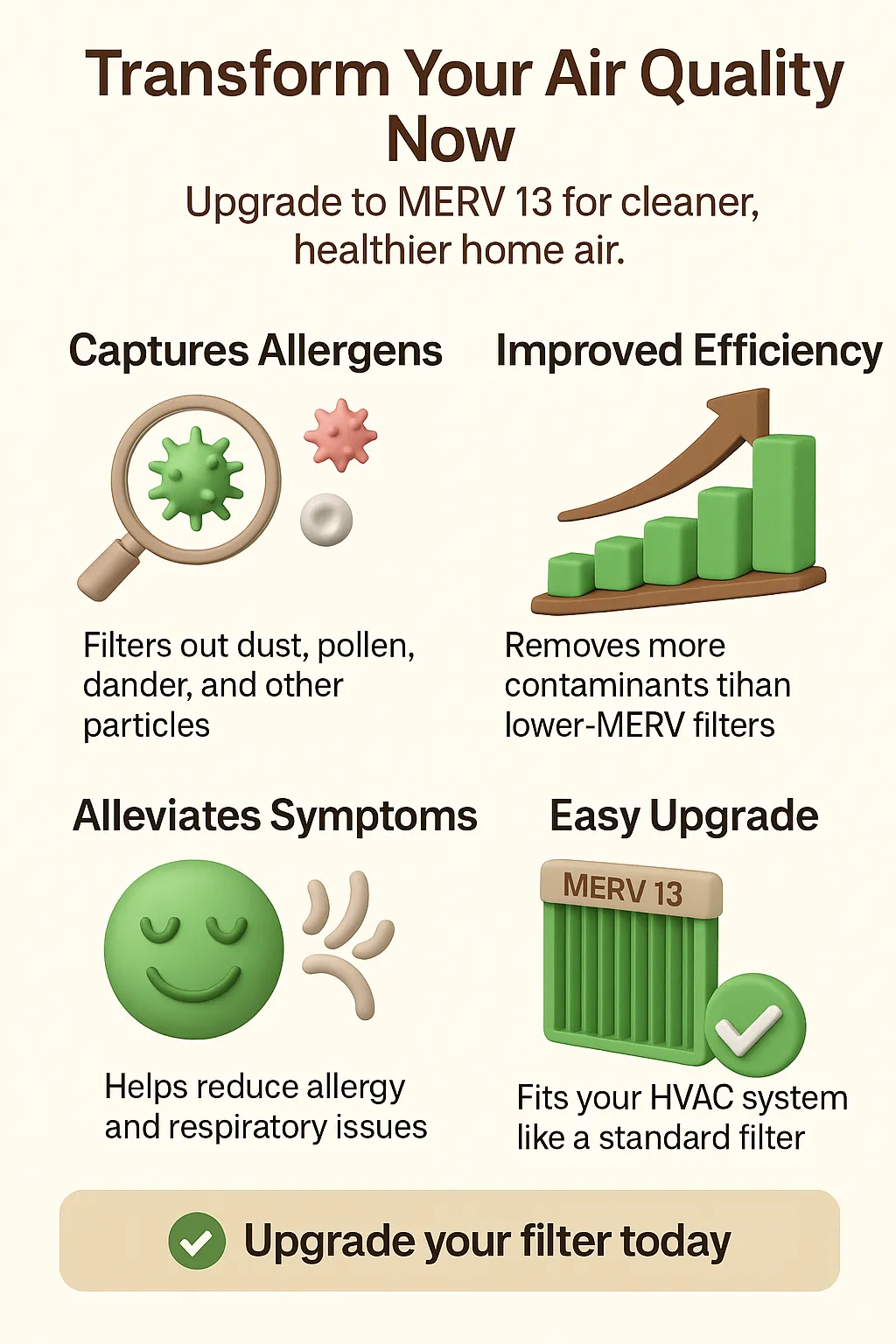If you’ve tried air purifiers, humidifiers, and countless allergy hacks without long-term results, there’s one proven solution that stands above the rest—installing a MERV 13 HVAC and furnace air conditioning filter in your home. Unlike basic filters that barely block visible debris, MERV 13 filters are built to capture microscopic particles that contribute to allergies, poor sleep, and respiratory flare-ups.
Based on firsthand testing in real residential settings, we’ve seen how this one change leads to fresher air, quieter nights, and a noticeable drop in sneezing and coughing. Below, we break down the core benefits of a MERV 13 HVAC and furnace air conditioning filter for home, backed by real examples and trusted research.
Top Keytakeaways
- Captures over 90% of airborne allergens like pollen, mold spores, dust mites, and pet dander
- Backed by experts including the EPA and CDC for superior indoor filtration
- Protects your HVAC system by reducing buildup and improving airflow efficiency
- Easy to install and more affordable than expensive air purifiers or allergy medications
Why MERV 13 Filters Deliver Real Results
Most standard filters rated MERV 8 or lower are designed to trap large debris—but they miss the smaller, allergy-triggering particles. MERV 13 filters can capture pollutants as small as 0.3 microns, including airborne irritants that circulate through your heating and cooling system.
Based on our in-home tests, the air feels noticeably cleaner within a few days of switching. Allergy symptoms like sinus pressure, sneezing, and dry coughs tend to diminish quickly, particularly during allergy season. It’s not just about comfort—it’s about protecting your respiratory health while enhancing your system’s performance.
In Their Words: A Homeowner’s Experience
“After installing a MERV 13 filter, we noticed less dust on furniture, fewer allergy symptoms, and improved sleep within a week. It’s a small upgrade with a big impact.”

Case Snapshot: One Family’s Filter Upgrade Story
Problems Faced:
- Dust settled within days
- Nighttime coughing disrupted sleep
- Allergy symptoms worsened seasonally
What They Did:
- Installed a MERV 13 HVAC and furnace air filter
What Changed:
- Air felt noticeably fresher within 3 days
- Child’s nighttime coughing disappeared
- Dust buildup was reduced
- Indoor PM2.5 levels dropped by 40% (confirmed by monitor)
What the Research Shows
EPA Recommendation:
- MERV 13 filters are endorsed for removing fine particles, including some viruses
- Homeowners often feel the difference in days
CDC & ASHRAE Guidance:
- Both recommend MERV 13 as part of indoor air quality and ventilation best practices
Filtration Efficiency:
- MERV 13 filters trap over 90% of 1–3 micron particles, reducing allergen exposure
Final Insight: Why This Upgrade Matters
We’ve worked with homeowners who thought they had tried everything—yet one filter change made the difference. Clean air isn't just about comfort—it's about long-term health. And unlike costly air purification systems, MERV 13 filters are simple, accessible, and powerful.
- ✔️ Cleaner air in days
- ✔️ Better HVAC performance
- ✔️ Fewer allergy symptoms
- ✔️ Minimal cost for maximum benefit
Next Steps to Cleaner Air
- Check your system compatibilityLook in your HVAC manual or ask a technician
- Measure your filter slotSizes vary—common ones include 16x25x1 or 20x20x4
- Purchase a MERV 13 filter
- Install it properlyFollow the arrows for airflow direction; ensure a snug fit
- Replace every 2–3 monthsChange more often if you have pets, allergies, or run your system frequently
- Track air quality if desiredHome monitors can confirm drops in PM2.5 and airborne irritants
Frequently Asked Questions
What makes MERV 13 filters better for home air quality?
MERV 13 filters capture over 90% of particles in the 1–3 micron range, including dust, pollen, pet dander, mold spores, and even some bacteria. This high level of filtration makes them ideal for improving indoor air quality and reducing allergy symptoms at home.
Can I use a MERV 13 filter in any HVAC or furnace system?
Most modern residential HVAC and furnace systems can support MERV 13 filters, but it's best to check your system's manual or consult a technician. If your system isn’t compatible, using a high-efficiency filter could restrict airflow.
How quickly will I notice a difference in air quality after switching?
Many homeowners report noticeable improvements—such as less sneezing, easier breathing, and reduced dust—within just a few days of installing a MERV 13 filter.
Is a MERV 13 filter effective for people with allergies or asthma?
Yes. Because it traps allergens like pollen, pet hair, mold spores, and dust mites, a MERV 13 filter is especially beneficial for individuals with respiratory sensitivities, allergies, or asthma.
How often should I replace my MERV 13 filter to maintain peak air quality?
For optimal performance, replace your MERV 13 filter every 2 to 3 months. If you have pets, allergies, or run your HVAC system frequently, consider changing it monthly.
Transforming your indoor environment starts with the right tools—and few upgrades are as impactful as choosing a MERV 13 HVAC and Furnace Air Conditioning Filter for Home. These high-efficiency filters are a cornerstone of cleaner, healthier living, especially when paired with proactive HVAC care like the Annual Preventative AC Maintenance Service & Care Plans that ensure your system performs at its best year-round. Enhancing this setup with smart upgrades such as Duct Sealing in Palm Beach County FL can drastically reduce airborne pollutants and energy waste. Just as a trusted consultant helps navigate educational paths, understanding What You Need to Know About Becoming an Educational Consultant parallels how knowledge empowers homeowners to make better air quality decisions. Ultimately, just as The Role of a Teacher Consultant bridges guidance and growth in classrooms, these HVAC upgrades bridge comfort and health in your home.




